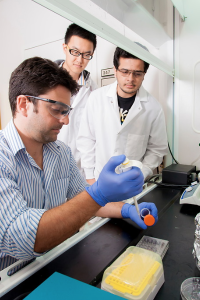Document Type
Article
Publication Title
Biomedical Materials
Abstract
Application of tissue-engineered vascular grafts (TEVGs) for the replacement of small-diameter arteries is limited due to thrombosis and intimal hyperplasia. Previous studies have attempted to address the limitations of TEVGs by developing scaffolds that mimic the composition (collagen and elastin) of native arteries to better match the mechanical properties of the graft with the native tissue. However, most existing scaffolds do not recapitulate the aligned topography of the collagen fibers found in native vessels. In the current study, based on the principles of isoelectric focusing, two different types of elastin (soluble and insoluble) were incorporated into highly oriented electrochemically aligned collagen (ELAC) fibers and the effect of elastin incorporation on the mechanical properties of the ELAC fibers and smooth muscle cell (SMC) phenotype was investigated. The results indicate that elastin incorporation significantly decreased the modulus of ELAC fibers to converge upon that of native vessels. Further, a significant increase in yield strain and decrease in Young’s modulus was observed on all fibers post SMC culture compared with before the culture. Real-time polymerase chain reaction results showed a significant increase in the expression of α-smooth muscle actin and calponin on ELAC fibers with insoluble elastin, suggesting that incorporation of insoluble elastin induces a contractile phenotype in SMCs after two weeks of culture on ELAC fibers. Immunofluorescence results showed that calponin expression increased with time on all fibers. In conclusion, insoluble elastin incorporated ELAC fibers have the potential to be used for the development of functional TEVGs for the repair and replacement of small-diameter arteries.
DOI
10.1088/1748-6041/11/2/025008
Publication Date
3-17-2016
Recommended Citation
Nguyen, T. -., Bashur, C. A., & Kishore, V. (2016). Impact of elastin incorporation into electrochemically aligned collagen fibers on mechanical properties and smooth muscle cell phenotype. Biomedical Materials (Bristol), 11(2)


